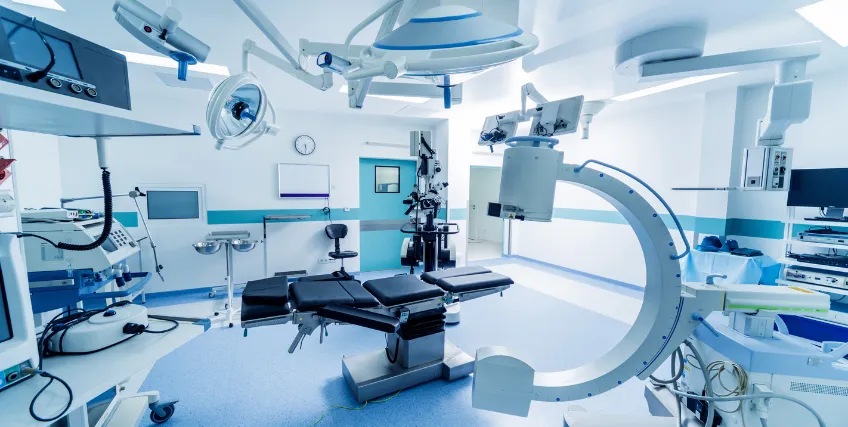
Starting a private medical practice can feel intimidating. While a private practice may raise your earning potential and enable you to give the best care possible to patients, there are many risks involved, too. The American Medical Association (AMA) reports that the number of physicians working in a private practice has been falling, due in large part to difficulties faced by doctors opening their own practices.
Whether it’s needing a practice loan to open the business, loans for surgery and other medical procedures, or difficulty establishing relationships with suppliers and vendors, there’s a lot to consider when opening a medical practice.
In this article:
- A step-by-step guide to opening a medical practice.
- How to get physician practice loans, loans for surgery, and other medical practice financing.
- What to expect when opening a private practice.
Steps to Start a Medical Practice
Establishing a medical practice from the ground up is hard work. You’re accountable for every decision, from drafting the company strategy to handling the credentialing process, selecting appropriate administrative procedures and collecting medical bills from patients and health insurance companies.
The credential application process alone may take over six months, so it’s important to get started early.
1. Draft a detailed strategy for your company
A business plan is an estimate of your projected income, costs, and debt over a period of three to five years. This important document can be shown to potential investors or on a loan application when applying for medical financing to help lenders understand the medical treatments your company offers, the patients you serve, and how you collect on medical debt.
Your business strategy should contain the following components:
- Executive summary: This will include the most important information about your practice, such as the name, location, and services that you want to provide, as well as your company’s mission statement and goals.
- Business overview: This section answers questions about clientele, business operations, the kinds of elective or essential treatments you’ll offer, payment plans and financing programs you may offer to patients to pay medical expenses, and more.
- Budget: Your budget breaks down expected medical and operational costs for the business. This should include any monthly payments on loans or origination fees necessary to start the business, as well as expected operating expenses. (For example, loans for medical professionals might be necessary not just to start the business, but to pay upfront costs of credentials or malpractice insurance.) Try to be as specific as possible, from the cost of office supplies to the fees associated with processing credit cards.
- Financial forecasts: While it may be difficult to project incomes, an important part of a business plan is thinking about your financial situation in the future to understand when you may need additional funding, loans for surgery, and other medical procedures you may plan to incorporate later, and other financial assistance you may expect to be necessary.
- SWOT analysis: SWOT stands for Strengths, Weaknesses, Opportunities, and Threats and is a valuable part of a business plan that analyzes your specific market segment. Remember that the estimates you make for your costs in the primary care sector may change over time. For instance, while interest rates may go down, the price of medical supplies may go up.
2. Financing
Typically, you’ll need medical practice financing to get started. It’s important to start by writing a business plan because it may play an important role in securing a physician practice loan.
During this stage, research lenders will find options with a medical department. Due to the risks involved in medical practices and the debt many borrowers carry from medical school, some medical professionals may have difficulty obtaining conventional bank loans.
Lenders with expertise in the medical industry are more understanding and willing to work with medical professionals who need medical practice financing or loans for surgery and other business essentials. Remember to look at traditional financial institutions like banks, credit unions and online lenders.
Different lenders have different eligibility requirements, and any borrower will have to submit to a hard credit check from the major bureaus. Your loan application and financial situation will determine your annual percentage rate (APR) and loan terms.
3. Organize your documentation and certifications
Getting financing in line is just the tip of the iceberg for opening a medical practice. You’ll also need to complete a lot of documentation and apply for a variety of certifications and permits. This includes but is not necessarily limited to the following items:
Business licensing
Incorporating your company as a legal entity is mandatory. American business entities include sole proprietorships, partnerships, LLCs, S-corps, and C-corps, which comes with legal responsibilities.
If you need assistance determining which option suits your practice’s requirements, you should speak with a lawyer and/or an accountant.
Additionally, you must get a tax ID or employer identification number (EIN) to meet IRS tax compliance requirements.
Insurance coverage
As a physician and owner of a company, you need to have commercial liability insurance and medical malpractice insurance. Malpractice insurance can be incredibly costly, so you will need to look into it carefully. The American Medical Association (AMA) reports that 1 in 3 physicians has been sued, while 1 in 2 will be sued by age 55.
In addition, your lender will most likely need you to provide evidence that you are covered, especially if you’re looking for loans for surgery at an established practice. You may also want to consider purchasing other kinds of insurance, such as disability or workers’ compensation.
Licensure from the state
Each state has different licensure requirements, but you will certainly need to apply for medical licensure. Research the requirements carefully depending on where you plan to open your practice.
Registration with the DEA
In order to prescribe medication, you must register with the Drug Enforcement Administration (DEA). DEA numbers are assigned to healthcare providers to regulate and track the prescription of controlled substances. While there are certain antibiotics that are not considered controlled substances – and therefore do not require a DEA number – you will likely need to register for a DEA number.
Additionally, even if you don’t typically prescribe controlled substances, having a DEA number can make it easier to accept specific patient insurance plans. Pharmacies also typically use DEA numbers when identifying the prescriber. Thus, it’s generally best to open your practice with a DEA number to ensure things run smoothly.
Other forms of documentation
Depending on the kind of practice you run and your services, you could be required to get additional certifications. For instance, accreditation from the Clinical Laboratory Improvement Amendments (CLIA) program is necessary for in-office labs.
Credentialing
To accept health insurance, you need to be credentialed with each insurance company. Because this procedure might take as long as six months, it is essential to get started as soon as possible. Meanwhile, make sure to open a business bank account for your practice.
Insurers will request your medical license, employment history, evidence of malpractice insurance (which varies by state and specialization), and information about your medical school and residency.
After that, you’ll have to engage in contract negotiations with your insurance over the terms of payment.
4. Find a location
Next, it’s time to find a location for your practice. Consider the local competition, the availability of parking, and the pros and cons of operating out of a multi-use location as opposed to a standalone clinic.
If any renovations need to be done, include that in your launch timeline and ensure you have financing to cover the costs. You don’t want to end up spending a lot more money than you initially intended to open.
Getting your physical practice up and running it properly requires the following steps:
- Pick a real estate location
- Negotiate the terms of the lease
- Take out a lease
- Obtain a Certificate of Occupancy as soon as possible
- Choose appropriate furnishings and signs
Be sure also to have any renovations or layout changes approved by the landlord before signing the lease. You don’t want to end up in a position where you can’t make the necessary changes.
5. Invest in necessary tools and software
Next, you must invest in medical equipment, office supplies, and practice management software to assist you with essential administrative tasks like appointment scheduling and client invoicing. Ensure that you get the following:
- Office equipment: You will want a computer, a photocopier, a phone, internet access, and a desk and chair for the reception area.
- Software for managing medical practices: Crucial tasks like scheduling, medical billing, reporting, insurance verification, and fee schedule dissemination will be made easier with the right software. You don’t want to waste your valuable time on repetitive tasks that could be automated. This is less time you can spend working with patients and on other practice matters that need your attention. The more you can automate, the better.
- Electronic health record (EHR) system: Additionally, you will want to consider software that also features a patient portal. That way, those who utilize your services can access their information safely and communicate with you. These sorts of systems are becoming quite popular among healthcare providers. It is important to ensure you are keeping up with the times.
- Additional software: Services such as credit card processing and medical transcription software are examples of other software solutions that you may want to consider.
6. Establish a website and get started with the marketing
When you’ve finished setting up your technology, it’s time to turn your attention to promoting your practice. When it comes to marketing your medical practice, there are several different aspects to consider:
- Make a website: Developing a website is crucial. This is a chance for you to really explain your practice and everything you offer. You should include bios on all the physicians working in your practice, their credentials, and what services they offer. You should also have a way for individuals to contact your practice through your site, including a phone number and an online inquiry form.
- Digital advertising: SEO, Google Ads, social media marketing, and content marketing are all examples of digital advertising.
- Direct marketing and marketing through email: Campaigns through email and direct mail are two methods that may be used to effectively spread the news about your new practice.
How Much Does It Cost to Open a Medical Practice?
The amount of capital you will need to open a new medical practice varies greatly depending on the type of practice and its location. Some practices require very little initial investment, while others may require hundreds of thousands of dollars or more. ProVise Management Group estimates that startup costs range between $70,000 to $100,000.
It’s important to understand your expected startup costs so you know the right medical loan amount to apply for. Before getting started, make sure to create a comprehensive budget and consider all aspects of what it takes to run a successful medical practice.
If you’re applying for a loan, aim to lock in repayment terms that make sense for your new business and limit your out-of-pocket costs, especially since many doctors are still dealing with student debt.
It’s a good idea to speak to other specialists about their own experiences, starting private practices to get an idea of both expected and unexpected costs. Even if your good credit ensures significant loan funds and a low interest rate, it’s important to build some allowances into your budget to cover unforeseen costs such as marketing, supplies, and payroll. Likewise, you never know when you might need to go back to lenders for loans for surgery and other loan options to finance additional services.
How to Finance a Medical Practice
Opening a medical practice is expensive. Fortunately, there are various financing options available for individuals looking to open a medical practice. Small business loans, lines of credit, and other loan options can provide the money needed for startup costs like equipment, office space, staff salaries, and more.
As noted previously, it can be difficult to get some of these loans because medical practices are often seen as risky businesses. So, be prepared to get turned down and stick with it. Perseverance is key when trying to find the right loan.
Term loans
Term loans are what most people think of when they think of a loan. It’s a lump sum of upfront money paid to a business with specific repayment terms. Usually, a term loan has a fixed interest rate and monthly payments for a specified period, but sometimes they may have variable interest rates that change throughout the lifetime of the loan.
These business loans are typically secured loans, meaning they require collateral like business or personal assets that the lender may seize if you default on the loan. Unsecured loans certainly exist, but you may have to make a higher down payment or meet other eligibility requirements.
There may be a lot of nuances involved in small business term loans, like prepayment penalties and origination fees, so it’s important to review loan terms carefully with an accountant and lawyer.
SBA Loans
U.S. Small Business Administration (SBA) loans are a popular resource for individuals seeking to open a medical practice. SBA loans will almost always offer borrowers the best possible interest rate, and are backed by the federal government, thereby reducing risk for the lender.
The drawbacks to SBA loans, however, are that they may be difficult to qualify for and slow to fund. Usually, you’ll need a very good credit history and a strong business plan. SBA loans tend to have higher minimum credit score requirements than other loans.
Line of Credit
A business line of credit is a more flexible medical practice financing option. A cross between a term loan and a business credit card, with a line of credit, you’re approved for a maximum loan amount that you may draw on when you need funding. Rather than pay interest on the full amount, you only pay fees and interest on the amount you withdraw. When you repay the loan amount, plus interest, you’ll have access to the full amount again.
This can be a great alternative for individuals who don’t want to take out an unsecured personal loan or tie up business assets with a large loan amount. This flexible financing may serve as a good loan for surgery or other one-time procedures or even provide an increase of cash flow if health insurers are taking a long time to pay bills.
Lines of credit typically carry higher interest rates than term loans, so it’s important to do some research before applying.
Grants
Government grants can be a great asset for individuals trying to start medical practice, especially in areas that are underserved by the medical community. There are often government incentives to open private practices or specialist offices in rural or underserved urban communities.
Final Thoughts
Starting medical practice is hard work. It requires long hours and dedication, as well as real medical know-how and professionalism. However, with the right approach, it’s an achievable goal. There are hundreds of thousands of successful medical practices in the United States, and there is no reason yours couldn’t be one of them.
Whether you need help getting started with a private practice loan or you need loans for surgery and other medical procedures, this guide will help you streamline the funding process.
FAQs on loans for surgery
How much does it cost to open a medical practice?
There are many factors that go into the startup costs of a medical practice, from the location to the services offered. ProVise Management Group estimates that general startup costs range between $70,000 to $100,000.
How can you finance a medical practice?
There are many ways to cover the startup costs for a medical practice, including term loans, SBA loans, and grants. If you’re looking for loans for surgery or other medical procedures, you might explore financing costs with a business line of credit or business credit card.
Can I get a loan if I have bad credit?
It is possible to get financing with bad credit, although you’re more likely to pay higher interest rates or have more punitive loan terms. Generally, online lenders are more willing to work with business owners with bad credit than traditional banks are.
What documentation do you need to start medical practice?
Different states have different documentation and credential requirements, so it’s important to do your research before beginning the process of opening a medical practice. , However, you’ll need to get business licensure, a tax ID like an EIN, insurance coverage, DEA credentials, and credentials from the state medical board.




